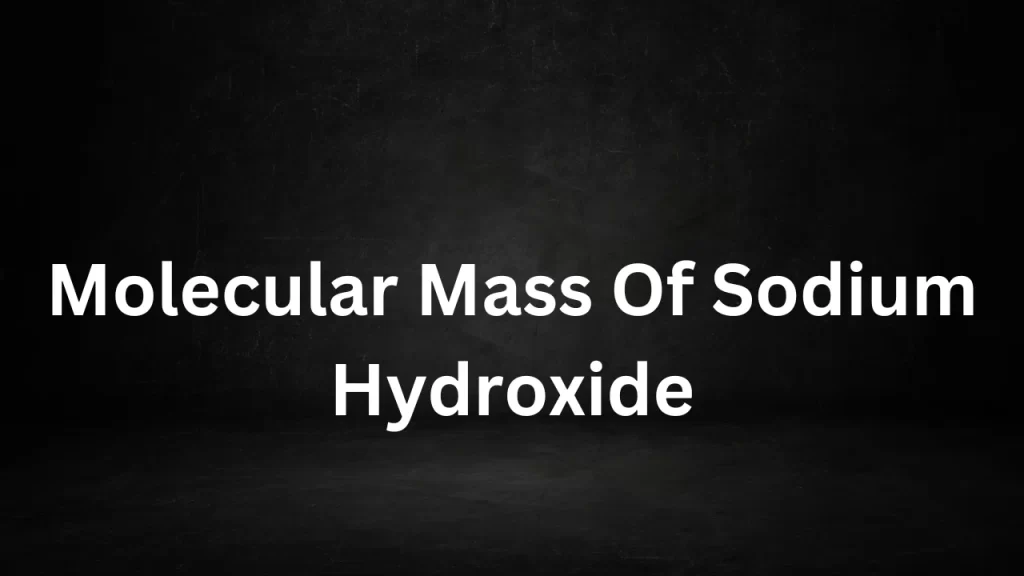Tag: caustic soda molar mass
Molecular Mass Of Sodium Hydroxide
Molecular Mass Of Sodium Hydroxide: The mole mass of sodium hydroxide (NaOH) is a critical concept in chemistry, providing essential information about the composition and weight of this commonly used compound.
Sodium hydroxide, also known as caustic soda or lye, plays a pivotal role in various industrial processes, scientific experiments, and even household applications. In this article, we will explore what the molecular mass of sodium hydroxide is, how it is calculated, its significance in different fields, and its practical applications.

Molecular Mass Of Sodium Hydroxide
Understanding Molecular Mass
Molecular mass, also known as molar mass, refers to the mass of one mole of a specific substance, expressed in grams per mole (g/mol). In the case of sodium hydroxide (NaOH), its molecular mass represents the combined mass of one mole of sodium (Na) atoms, one mole of oxygen (O) atoms, and one mole of hydrogen (H) atoms.
Calculating the Molecular Mass
To calculate the mole mass of sodium hydroxide (NaOH), we add the atomic masses of its constituent elements:
- Sodium (Na): Atomic mass ≈ 22.99 g/mol
- Oxygen (O): Atomic mass ≈ 16.00 g/mol
- Hydrogen (H): Atomic mass ≈ 1.01 g/mol
Now, let’s calculate the mole mass of NaOH:
Molecular Mass of NaOH = (Molar Mass of Na) + (Molar Mass of O) + (Molar Mass of H) Molecular Mass of NaOH = (22.99 g/mol) + (16.00 g/mol) + (1.01 g/mol) Molecular Mass of NaOH ≈ 40.00 g/mol
Therefore, the mole mass of sodium hydroxide (NaOH) is approximately 40.00 grams per mole (g/mol).
Significance in Chemistry
- Stoichiometry: Sodium hydroxide’s molar mass is fundamental in stoichiometry, which involves calculating the quantities of reactants and products in chemical reactions involving NaOH. This plays a crucial role in various chemical industries.
- Analytical Chemistry: In laboratories, precise measurements of reagents and solutions, including sodium hydroxide, rely on its molar mass for accurate calculations and analytical procedures.
- Titration: Sodium hydroxide is often used as a strong base in titration experiments, where the molar mass is essential for determining the concentration of acids or other substances.
Practical Applications
- Chemical Manufacturing: Sodium hydroxide is a key ingredient in the production of various chemicals, including detergents, paper, textiles, and soap. Its molar mass is crucial in formulating these products.
- Water Treatment: In water treatment plants, NaOH is used for pH adjustment and water purification. Its molar mass is essential for precise dosing and chemical treatment.
- Soap and Cleaning Products: Sodium hydroxide is used in the production of soap and cleaning agents. Its molar mass influences product formulations and properties.
- Food Industry: It is employed for food preparation and processing, particularly in the production of foods like pretzels and hominy. Its molar mass is important for adherence to safety regulations.
Conclusion
The mole mass of sodium hydroxide (NaOH), approximately 40.00 g/mol, is a fundamental concept in chemistry with wide-reaching applications. It is indispensable in stoichiometry, analytical chemistry, and titration experiments, providing accurate measurements and calculations. Sodium hydroxide’s significance extends to various industries, including chemical manufacturing, water treatment, and the production of soap and cleaning products. Understanding the mole mass of sodium hydroxide is not only a foundational concept in chemistry but also a key factor in addressing practical challenges in diverse fields, from industrial processes to everyday applications.
Read More
- Molar Mass Of Ethyl Alcohol
- Molecular Mass Of Calcium Carbonate
- Molar Mass Of Carbon Dioxide
- Difference Between Force And Momentum
- Law Of Conservation Of Linear Momentum
- Molecular Weight Of MgSO4
- Molecular Weight Of H3PO4
Frequently Asked Questions (FAQs) On Molecular Mass Of Sodium Hydroxide
1. What is the molecular mass of sodium hydroxide (NaOH)?
The molecular mass of sodium hydroxide (NaOH) is approximately 40.00 grams per mole (g/mol).
2. How is the molecular mass of sodium hydroxide calculated?
To determine the molecular mass of NaOH, one adds together the atomic masses of its component elements: sodium (Na), oxygen (O), and hydrogen (H).
3. What is the atomic mass of sodium (Na)?
The atomic mass of sodium is approximately 22.99 g/mol.
4. What is the atomic mass of oxygen (O)?
The atomic mass of oxygen is approximately 16.00 g/mol.
5. What is the atomic mass of hydrogen (H)?
The atomic mass of hydrogen is approximately 1.01 g/mol.
Molecular Weight Of Sodium Hydroxide
Molecular Weight Of Sodium Hydroxide: When it comes to understanding the properties and behavior of chemicals, one fundamental concept that chemists rely on is the molecular weight.
The molecular weight, often referred to as the molar mass or molecular mass, is a crucial parameter in chemistry that provides insights into the composition of a compound. In this article, we will explore the molecular weight of sodium hydroxide (NaOH), a common and important chemical compound.

Molecular Weight Of Sodium Hydroxide
Sodium Hydroxide (NaOH): The Basics
Before delving into the molecular weight of sodium hydroxide, let’s familiarize ourselves with this compound. Sodium hydroxide, with the chemical formula NaOH, is an inorganic compound that plays a significant role in various industries, including chemical manufacturing, water treatment, and the production of soaps and detergents. It is frequently referred to as caustic soda or lye.
Sodium hydroxide is a white, solid substance at room temperature and is highly soluble in water. It is known for its strong alkaline properties and is classified as a strong base. When dissolved in water, it dissociates into its constituent ions, sodium ions (Na⁺) and hydroxide ions (OH⁻). This dissociation is crucial to understanding its molecular weight.
Calculating the Molecular Weight
The molecular weight of a compound is ascertained by summing the atomic weights of all the constituent atoms within a single molecule of that compound. In the case of sodium hydroxide (NaOH), we have three elements: sodium (Na), oxygen (O), and hydrogen (H).
Let’s break down the atomic weights of these elements:
- Sodium (Na) has an atomic weight of approximately 22.99 grams per mole.
- Oxygen (O) has an atomic weight of approximately 15.999 grams per mole.
- Hydrogen (H) has an atomic weight of approximately 1.008 grams per mole.
To calculate the molecular weight of sodium hydroxide, we sum the atomic weights:
Molecular Weight (NaOH) = Atomic Weight(Na) + Atomic Weight(O) + Atomic Weight(H) Molecular Weight (NaOH) = 22.99 g/mol + 15.999 g/mol + 1.008 g/mol
Molecular Weight (NaOH) ≈ 39.997 g/mol
So, the molecular weight of sodium hydroxide (NaOH) is approximately 39.997 grams per mole.
Significance of Molecular Weight
Understanding the molecular weight of a compound is vital in various aspects of chemistry and science. Here are some key reasons why it’s important:
- Stoichiometry: Molecular weight is essential in balancing chemical equations and determining the quantitative relationships between reactants and products in chemical reactions.
- Concentration Calculations: It helps in calculating the concentration of a substance in a solution, which is crucial in analytical chemistry and laboratory work.
- It serves as a fundamental factor utilized in various chemical computations, encompassing stoichiometry, concentration determination, and molar mass calculations.
- Physical Properties: Molecular weight influences the physical properties of a compound, such as its melting point, boiling point, and density.
In conclusion, the mole weight of sodium hydroxide (NaOH) is approximately 39.997 grams per mole. This value is a fundamental piece of information that aids chemists and scientists in their work, from conducting chemical reactions to formulating solutions and understanding the behavior of this important compound in various applications. Sodium hydroxide’s molecular weight serves as a building block for deeper insights into its chemical properties and its role in diverse industrial processes.
Read More
- Molecular Weight Of Aluminium
- Molecular Weight Of CaCl2
- Molecular Weight Of Copper
- Molecular Mass Of Ethanol
- Molecular Mass of Ammonia
Frequently Asked Questions (FAQs) Molecular Weight Of Sodium Hydroxide
1. What is the molecular weight of sodium hydroxide (NaOH)?
The mole weight of sodium hydroxide (NaOH) is approximately 39.997 grams per mole.
2. Why is it important to know the molecular weight of sodium hydroxide?
Knowing the mole weight of sodium hydroxide is essential in chemistry as it helps chemists understand the composition of the compound. It serves as a fundamental factor utilized in various chemical computations, encompassing stoichiometry, concentration determination, and molar mass calculations.
3. What is sodium hydroxide (NaOH), and where is it commonly used?
Sodium hydroxide, chemically denoted as NaOH, is an inorganic substance widely acknowledged as caustic soda or lye. This highly alkaline compound sees extensive application in chemical manufacturing, water treatment, the manufacturing of soaps and detergents, and various industrial processes.
4. How is the molecular weight of sodium hydroxide calculated?
To determine the mole weight of sodium hydroxide (NaOH), one simply sums the atomic weights of its component elements: sodium (Na), oxygen (O), and hydrogen (H). For NaOH, the calculation is straightforward:
Molecular Weight (NaOH) = Atomic Weight(Na) + Atomic Weight(O) + Atomic Weight(H)
The Molecular Weight (NaOH) = 22.99 g/mol + 15.999 g/mol + 1.008 g/mol
Molecular Weight (NaOH) ≈ 39.997 g/mol
5. What are the practical applications of understanding the molecular weight of sodium hydroxide?
Understanding the mole weight of sodium hydroxide is crucial in a wide range of chemical and industrial processes. It finds application in establishing reaction stoichiometry, computing concentrations within solutions, determining molar masses, and making predictions regarding the physical characteristics of the compound.